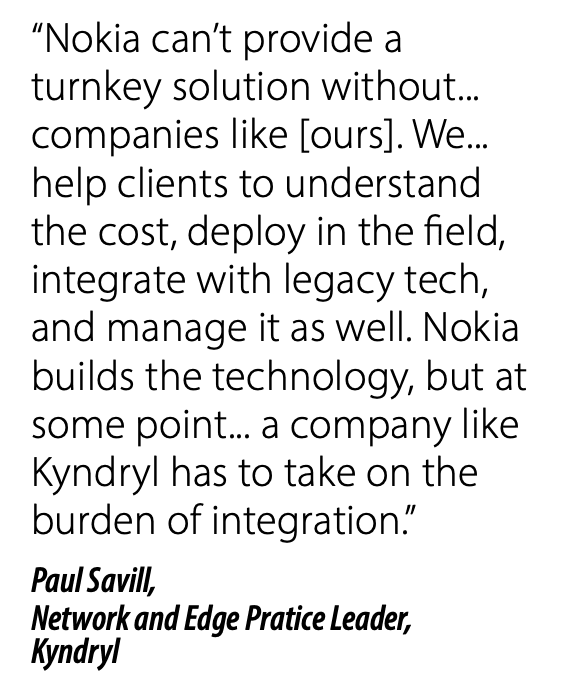This is article is taken from a recent editorial report on Industrial 5G Innovation – From Setting Standard to Becoming Standard; the previous instalment in this serialised version of the report is available here. Subsequent instalments are listed below (linking either to the original report, or to web articles, as they are available). The report includes additional features and interviews, and is available here. A webinar on the same topic is also available, here, with speakers from ABI Research, MFA, Schneider Electric, and Vodafone.
One of those sales channels – the biggest of them, a channel all by itself, we hear – is New York-based managed infrastructure services provider Kyndryl, separated from IBM late last year, which the Finnish firm signed with in February to jointly sell and develop private networking and edge computing solutions. It is a move that says 5G can be levered into industry with confidence, without complicating the rest of the digital change architecture, and made to scale quickly.
Nokia’s Stephane Daeuble again: “We started selling direct because, at the time, nobody knew what private wireless was. We used to deploy one site with a couple of use cases, let it run for a couple of years, and then expand. But we’ve seen, since the end of last year, that cellular is now established and trusted by almost all segments. Customers are signing up for 40-50 sites in one go, and buying the whole industrial edge; saying, ‘yeah, I’m all-in’. That is one of the big changes.”
In this long investigation into the quest for scale in the broad IoT networking market, Nokia and possibly NTT, as well, are the ones to have most clearly made the transition at the high-end, away from all the low-power sensing that has propped up the market to date. In a heartbeat, Nokia’s deal with Kyndryl, just like NTT’s with Schneider Electric, will see a one-site installation explode into a 200-site deployment.
 The Nokia/Kyndryl project with Dow Chemical promises to multiply to other mega-sized industrial clients; Kyndryl has 4,000 of them, it says. NTT’s arrangement with Schneider Electric has a unique resale component, which will see the latter integrate 5G into its prefab data centre proposition for its own customers. These look like the kinds of deals that will finally line-up and topple-down a domino-line of industrial 5G installations.
The Nokia/Kyndryl project with Dow Chemical promises to multiply to other mega-sized industrial clients; Kyndryl has 4,000 of them, it says. NTT’s arrangement with Schneider Electric has a unique resale component, which will see the latter integrate 5G into its prefab data centre proposition for its own customers. These look like the kinds of deals that will finally line-up and topple-down a domino-line of industrial 5G installations.
These are the deals that make the hype look like it might start to be real; like industrial 5G might just be the earth-quaking reset for industry. It is worth hearing from Kyndryl. Because whatever work Nokia has done to cookie-cut Industry 4.0, Kyndryl has the wider view – and all the deep industrial relations, all the wide technical artillery, and all the requisite certifications with the ‘big cloud providers’.
In terms of the Industry 4.0 design-build-run process for industrial mega firms, Kyndryl does it all – and does it better, it says (and Nokia says), than Nokia, and better also than any parochial mobile network operator. Paul Savill, networking and edge practice leader at the firm, says: “We’re building industry-specific integrated full-stack solutions that incorporate private 5G and IoT tech, plus integration back into the software-defined WAN and LAN technologies.
“Nokia cannot provide a complete turnkey solution without partnering with companies like Kyndryl. We look across all capabilities and make a recommendation… and help clients understand the cost structures, deploy in the field, integrate with legacy tech, and manage it as well. Nokia builds the technology, but at some point either the enterprise purchasing it or a company like Kyndryl has to take on the burden of integration.”
Suddenly, the cookie-cutter approach seems a likely story; NTT’s own system integration, about bashing heads in co-creation, looks likelier. Either way, the pair are gunning for the big time. But what is left? The small/mid sized (SME) market, of course. Because industrial 5G will not amount to a hill of beans if the great engine room of Industry 4.0 is not well appointed, as well; the cellular market will not claim scale if SMEs do not get a handle on it too.
In the end, 5G will not matter much if Industry 4.0 does not go beyond well-heeled mega-sized early-adopter companies like Dow Chemical and Schneider Electric, except as a technology that spreads digital-divide into the industrial market. So how does Mr. Man (Manufacturer) up the road with 50 staff putting rivets in joists get a voice in this narrative?
 Because this market is obsessed with selling to BMW and Lufthansa; how does the Rust Belt and the Northern Wall, and all these clichéd industrial heartlands which carry the Industry 4.0 supply chain, make a go of industrial 5G and digital change – when they are just trying to keep the lights on? So come on, my brain is tired; tell me about the kind of scale that actually matters.
Because this market is obsessed with selling to BMW and Lufthansa; how does the Rust Belt and the Northern Wall, and all these clichéd industrial heartlands which carry the Industry 4.0 supply chain, make a go of industrial 5G and digital change – when they are just trying to keep the lights on? So come on, my brain is tired; tell me about the kind of scale that actually matters.
And please; don’t talk about hyperscalers, even if they are the answer. NTT picks up the thread, and seems to contradict its line earlier that “every factory is different” (except it doesn’t, because its original statement was about breaking new ground). Ahmed says: “A SME warehouse, of 10,000 square feet, which just services containers coming in and out, has the same local-area problems as a decent sized BMW or Schneider Electric. But they only have one site.
“The question is: can they have a solution out-of-the-box, as-a-service, which is easy to install and manage, with their limited in-house IT/RF skills? And so long as they can, then I think SMEs will adopt this even faster than big enterprises. But most smaller businesses do not have the IT/RF skills. Most warehouses, all the way down to dentists’ offices, will have a difficult time to justify a private 5G network inside their site.
“I mean, if they can just do Wi-Fi; Wi-Fi 6 is good enough to track parcels or upload dental x-rays, so maybe that is all they need. So you have to ask whether there is even a need for private 5G in these SME businesses. But if there is – like with this machine vision example, which we know there is – you better have some really suitable subscription-based pricing.” Ah, stop already. When will NTT pitch-up for SMEs? When does this go massive-scale?
He responds, reminding us the new scale being achieved with the likes of Schneider Electric and Kyndryl/Dow only points to the market’s way out of spotty pubescence, and does not flag its maturity yet. “We will go down-market at some point. We just don’t have the sales capability yet,” says Ahmed. There is plenty more to say, and subsequent interviews with MFA, Vodafone, Nokia, and Schneider Electric itself flesh out this narrative further.
This is article is taken from a recent editorial report on Industrial 5G Innovation – From Setting Standard to Becoming Standard; the previous instalment in this serialised version of the report is available here. Subsequent instalments are listed below (linking either to the original report, or to web articles, as they are available). The report includes additional features and interviews, and is available here. A webinar on the same topic is also available, here, with speakers from ABI Research, MFA, Schneider Electric, and Vodafone.
The trouble with private 5G for Industry 4.0 | Part 1 – the standard
The trouble with private 5G for Industry 4.0 | Part 2 – the devices
The trouble with private 5G for Industry 4.0 | Part 3 – the spectrum
The trouble with private 5G for Industry 4.0 | Part 4 – the features
The trouble with private 5G for Industry 4.0 | Part 5 – the system
The trouble with private 5G for Industry 4.0 | Part 6 – the channel

